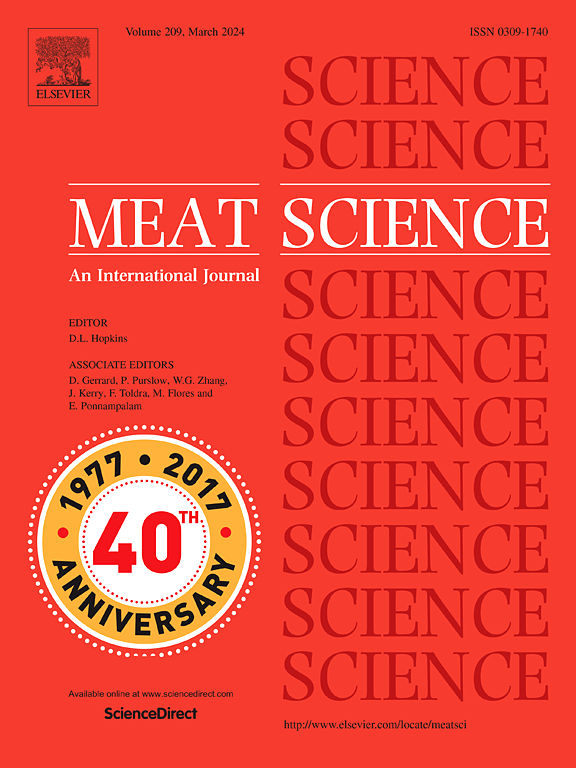滑动窗增强嗅觉视觉图像结合深度学习预测冷羊肉中TVB-N含量
IF 6.1
1区 农林科学
Q1 Agricultural and Biological Sciences
引用次数: 0
摘要
本研究提出了一种新的嗅觉视觉图像数据增强方法,结合深度学习实现了冷鲜羊肉中总挥发性碱性氮(TVB-N)含量的准确预测。具体而言,定义滑动窗口,并通过对滑动位置信息进行编码和解码,分别从每个感知区域提取不同的感兴趣区域,从而增强嗅觉视觉图像。该增强方法考虑了嗅觉可视化传感器阵列在制备和反应过程中敏感点的位置移位和颜色呈现不均的问题。在增强图像的基础上,建立了3种先进的深度学习模型(InceptionNetV3、ResNet50和MobileNetV3),并与基于人工提取色彩空间特征的偏最小二乘回归(PLSR)、支持向量回归(SVR)和随机森林(RF) 3种传统机器学习模型进行了比较。通过比较,InceptionNetV3、ResNet50和MobileNetV3的深度学习模型具有更好的预测性能,MobileNetV3模型获得了最优的预测结果。最佳预测模型的决定系数(R2)、均方根误差(RMSE)和相对预测偏差(RPD)分别为0.97、2.42 mg/100 g和5.82。结果表明,嗅觉可视化传感器阵列与轻便型MobileNetV3相结合,可以稳定有效地预测冷鲜羊肉中TVB-N的含量,在羊肉新鲜度现场评价中具有很大的应用潜力。本文章由计算机程序翻译,如有差异,请以英文原文为准。

Sliding-window enhanced olfactory visual images combined with deep learning to predict TVB-N content in chilled mutton
A novel data enhancement method for olfactory visual images was proposed in this study, combined with deep learning to achieve the accurate prediction of total volatile basic nitrogen (TVB-N) content in chilled mutton. Specifically, the sliding-window was defined and used to separately extract different regions of interest from each sensing region by encoding and decoding the sliding position information, so the olfactory visual image was enhanced. This enhancement method considered the position shift and uneven colour presentation of sensitive points during the preparation and reaction of olfactory visualization sensor array. Based on the enhanced images, three advanced deep learning models (InceptionNetV3, ResNet50 and MobileNetV3) were established, and compared with three traditional machine learning models of partial least squares regression (PLSR), support vector regression (SVR) and random forest (RF) based on manually extracted colour space features. By comparison, deep learning models of InceptionNetV3, ResNet50 and MobileNetV3 had better predictive performance, and the optimal prediction results were obtained by the MobileNetV3 model. The determination coefficient (R2), root-mean-square error (RMSE) and relative prediction deviation (RPD) of the best prediction model for test set were 0.97, 2.42 mg/100 g and 5.82, respectively. The results demonstrated that the combination of olfactory visualization sensor array and the lightweight MobileNetV3 can stably and effectively predict the TVB-N content in chilled mutton, and has great potential for on-site evaluation of mutton freshness.
求助全文
通过发布文献求助,成功后即可免费获取论文全文。
去求助
来源期刊

Meat Science
工程技术-食品科技
CiteScore
12.60
自引率
9.90%
发文量
282
审稿时长
60 days
期刊介绍:
The aim of Meat Science is to serve as a suitable platform for the dissemination of interdisciplinary and international knowledge on all factors influencing the properties of meat. While the journal primarily focuses on the flesh of mammals, contributions related to poultry will be considered if they enhance the overall understanding of the relationship between muscle nature and meat quality post mortem. Additionally, papers on large birds (e.g., emus, ostriches) as well as wild-captured mammals and crocodiles will be welcomed.
 求助内容:
求助内容: 应助结果提醒方式:
应助结果提醒方式:


